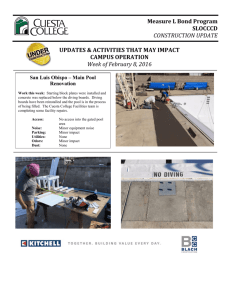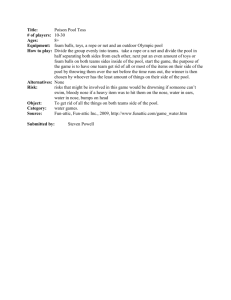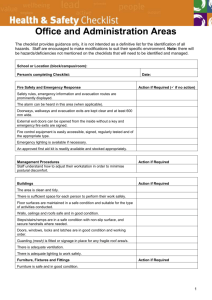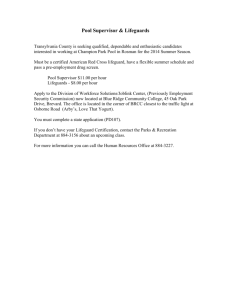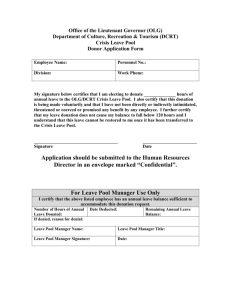Safety Inspection Checklist
advertisement
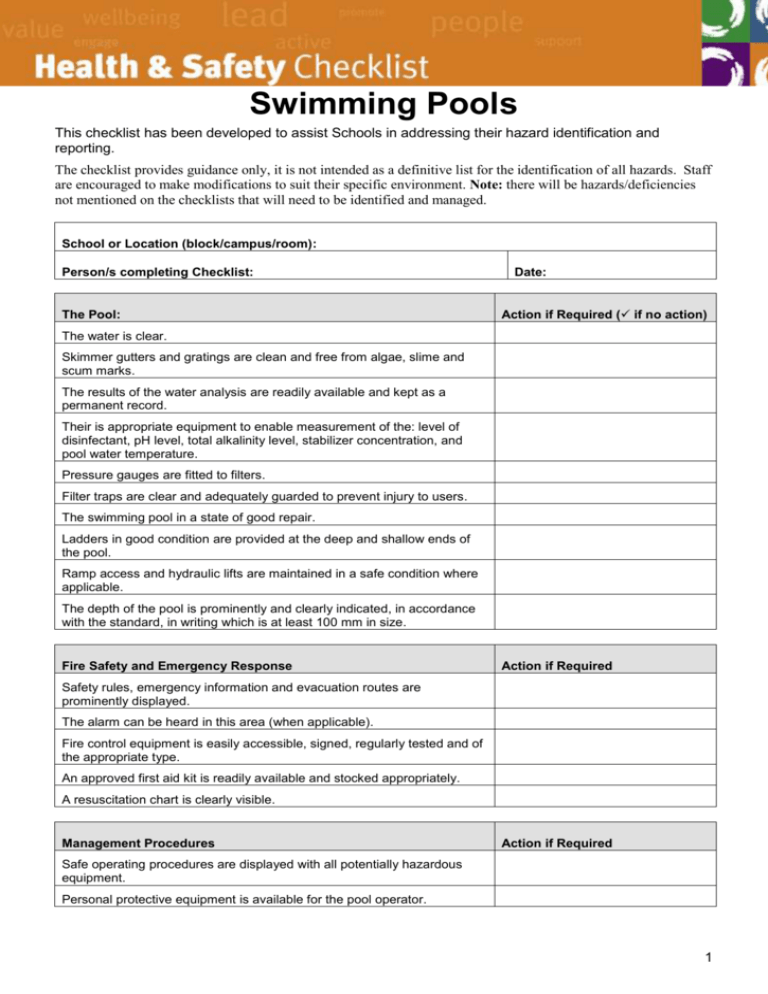
Swimming Pools This checklist has been developed to assist Schools in addressing their hazard identification and reporting. The checklist provides guidance only, it is not intended as a definitive list for the identification of all hazards. Staff are encouraged to make modifications to suit their specific environment. Note: there will be hazards/deficiencies not mentioned on the checklists that will need to be identified and managed. School or Location (block/campus/room): Person/s completing Checklist: The Pool: Date: Action if Required ( if no action) The water is clear. Skimmer gutters and gratings are clean and free from algae, slime and scum marks. The results of the water analysis are readily available and kept as a permanent record. Their is appropriate equipment to enable measurement of the: level of disinfectant, pH level, total alkalinity level, stabilizer concentration, and pool water temperature. Pressure gauges are fitted to filters. Filter traps are clear and adequately guarded to prevent injury to users. The swimming pool in a state of good repair. Ladders in good condition are provided at the deep and shallow ends of the pool. Ramp access and hydraulic lifts are maintained in a safe condition where applicable. The depth of the pool is prominently and clearly indicated, in accordance with the standard, in writing which is at least 100 mm in size. Fire Safety and Emergency Response Action if Required Safety rules, emergency information and evacuation routes are prominently displayed. The alarm can be heard in this area (when applicable). Fire control equipment is easily accessible, signed, regularly tested and of the appropriate type. An approved first aid kit is readily available and stocked appropriately. A resuscitation chart is clearly visible. Management Procedures Action if Required Safe operating procedures are displayed with all potentially hazardous equipment. Personal protective equipment is available for the pool operator. 1 All persons, while handling pool chemicals, should wear appropriate personal protective equipment to prevent the chemicals coming into contact with their skin, eyes or clothing and to avoid breathing any chemical dust or vapour. Pool Surrounds Action if Required The area is clean and tidy. Floor surfaces are non-slip, unbroken and maintained in a safe condition. Steps/stairs/ramps are in a safe condition with non-slip surface, and secure handrails where needed. Doors, gates, fences, locks and latches are in good condition and working order? Gates close automatically. Guarding (mesh) or signage is in place for any fragile roof area/s. Plants and trees are safe, non toxic and in good condition. The area is adequately shaded. Where a pool is enclosed, the ventilation is adequate. Where a pool is enclosed the building, lights, fixtures, fittings, windows etc, are safe and in good condition. Storage Action if Required Flammable material is stored and handled in a safe manner. Required resources and equipment stored safely. (e.g. separate from hazardous substances) Free standing shelves/cupboards are secured to ensure stability. Storage areas are labeled appropriately. (placarding of the chemical storage area is generally not necessary for quantities of pool chemicals under 500 litres or kilograms) Waste containers are readily available and labeled appropriately where necessary. Hazardous Substances Chlorine and acids, including empty containers are stored in separate locations. Action if Required (Note: acids will react with sodium or calcium hypochlorite to release toxic chlorine gas • chlorinated cyanurates will react with either acid or alkaline substances to produce explosive conditions due to the release of chlorine dioxide • calcium hypochlorite in contact with organic or oxidisable and combustible substances such as chlorine or petroleum products may form a mixture that spontaneously bursts into flames and in some instances may explode. There is an up to date register/stock control sheet to detail storage, handling requirements. The quantity of chlorine and/or acid stored is within recommended guidelines for the size of the pool. Current (within 5 years) material safety data sheets are readily available for hazardous substances. Hazardous substances are stored and labeled appropriately. Containers of acid are stored in a bunded area (or suitable tray/trough). Appropriate washing/dousing facilities are available in the event of an 2 accident with chemicals. Electrical Action if Required Electrical equipment in good condition and tested as required according to the department’s electrical testing procedure. The area has Residual Current Device (RCD) protection. Plant Action if Required Manuals are available for operating equipment and machinery. Swimming pool plant is identified on the site maintenance register. The moving parts of all machinery and equipment is guarded in accordance with the regulations. All machines are fitted with the appropriate safety signs and SOPs. All pool plant is safe and maintained in a state of good repair. Toilets Action if Required Toilet facilities are clean and in good condition. Items are available to maintain appropriate levels of hygiene. Change Rooms Action if Required Private and secure change rooms are available for change of clothing. The rooms are clean and in good condition. Hooks and other items are not hazardous. The floors are non slip. The floors are dry and well-drained after use. All sinks, drains and toilets are operating in a satisfactory manner. General Action if Required No other hazards such as sharps, glare, noise, fumes or vermin have been identified. All gas pipes are clearly labeled. All furniture is safe and in good condition. Isolation valves are readily accessible and clearly labeled. Other Issues Action if Required 3


